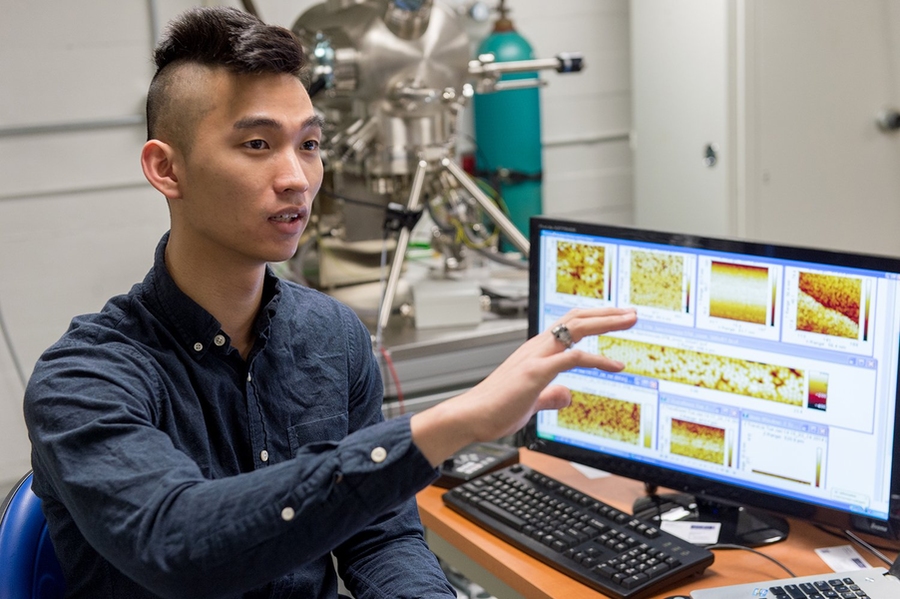Minh Dinh has always loved learning, but that love got a big boost when he was attending high school in Hue City, Vietnam, and a university enrichment program introduced him to nuclear physics. “I thought, wow, this stuff is so cool, I want to learn more about it — that’s when I decided to study nuclear engineering in college,” he recalls.
Dinh arrived at MIT in 2011 as a nuclear science and engineering (NSE) major, and he soon had another pivotal classroom experience in Professor Bilge Yildiz’s Materials for Nuclear Applications (22.070). “That class really got my attention and made me want to do more with materials,” he says. Now in his junior year with a 4.9 grade point average, Dinh has declared a double major with materials science and engineering and is a member of Yildiz’s research group in MIT’s Laboratory for Electrochemical Interfaces, working alongside graduate students and postdocs as part of the Institute’s Undergraduate Research Opportunities Program (UROP).
His research has included simulation analysis of solid oxide fuel cell (SOFC) performance, and exploration of the aging and degradation behavior of materials, including industry-sponsored studies of oil pipeline corrosion. The work draws heavily on groundbreaking surface analysis methods developed by Yildiz for the study of corrosion and electrochemical energy conversion materials.
“Minh is a great example of the UROP experience,” Yildiz says. “For the oil pipeline project, we asked him to assess how native coatings on metal surfaces may lose their anticorrosive qualities. He began with no knowledge of atomistic simulations but had tremendous eagerness to learn, and he’s now able to perform simulations and analyze and discuss his results, which are helping uncover how native coatings are fractured by ubiquitous hydrogen.” The work won an NSE Outstanding UROP Award and is being prepared for journal publication.
Dinh is now applying his love of programming to the performance of SOFC materials. Yildiz says Dinh’s knowledge and project experience allow him to tackle the work more independently, making a critical contribution to the group’s effort. “Experiments alone can’t point easily to the atomistic mechanisms in this problem, but Minh’s simulations can,” she says.
Click to read the full article.
Dinh arrived at MIT in 2011 as a nuclear science and engineering (NSE) major, and he soon had another pivotal classroom experience in Professor Bilge Yildiz’s Materials for Nuclear Applications (22.070). “That class really got my attention and made me want to do more with materials,” he says. Now in his junior year with a 4.9 grade point average, Dinh has declared a double major with materials science and engineering and is a member of Yildiz’s research group in MIT’s Laboratory for Electrochemical Interfaces, working alongside graduate students and postdocs as part of the Institute’s Undergraduate Research Opportunities Program (UROP).
His research has included simulation analysis of solid oxide fuel cell (SOFC) performance, and exploration of the aging and degradation behavior of materials, including industry-sponsored studies of oil pipeline corrosion. The work draws heavily on groundbreaking surface analysis methods developed by Yildiz for the study of corrosion and electrochemical energy conversion materials.
“Minh is a great example of the UROP experience,” Yildiz says. “For the oil pipeline project, we asked him to assess how native coatings on metal surfaces may lose their anticorrosive qualities. He began with no knowledge of atomistic simulations but had tremendous eagerness to learn, and he’s now able to perform simulations and analyze and discuss his results, which are helping uncover how native coatings are fractured by ubiquitous hydrogen.” The work won an NSE Outstanding UROP Award and is being prepared for journal publication.
Dinh is now applying his love of programming to the performance of SOFC materials. Yildiz says Dinh’s knowledge and project experience allow him to tackle the work more independently, making a critical contribution to the group’s effort. “Experiments alone can’t point easily to the atomistic mechanisms in this problem, but Minh’s simulations can,” she says.
Click to read the full article.






